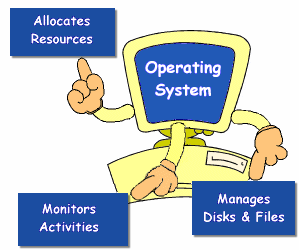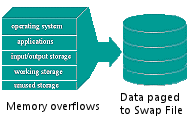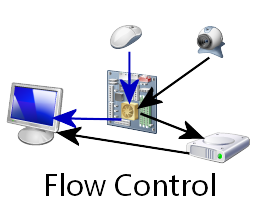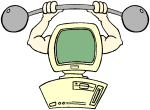Jan's Computer Basics:
System Software: Functions
All operating systems must handle the same basic tasks. These functions can be divided into three groups:

Allocating System Resources
The operating system directs the traffic inside the computer, deciding what resources will be used and for how long.
| Time |  Time in the CPU is divided into time slices which are measured in milliseconds. Each task the CPU does is assigned a certain number of time slices. When time expires, another task gets a turn. The first task must wait until it has another turn. Since time slices are so small, you usually can't tell that any sharing is going on. Tasks can be assigned priorities so that high priority (foreground) tasks get more time slices than low priority (background) tasks. Time in the CPU is divided into time slices which are measured in milliseconds. Each task the CPU does is assigned a certain number of time slices. When time expires, another task gets a turn. The first task must wait until it has another turn. Since time slices are so small, you usually can't tell that any sharing is going on. Tasks can be assigned priorities so that high priority (foreground) tasks get more time slices than low priority (background) tasks.
|
| Memory |  Memory must be managed also by the operating system. All those rotating turns of CPU use leave data waiting around in buffers. Care must be taken not to lose data!! One way to help out the traffic jam is to use virtual memory. This includes disk space as part of main memory. While it is slower to put data on a hard disk, it increases the amount of data that can be held in memory at one time. When the memory chips get full, some of the data is paged out to the hard disk. This is called swapping. Windows uses a swap file for this purpose. Memory must be managed also by the operating system. All those rotating turns of CPU use leave data waiting around in buffers. Care must be taken not to lose data!! One way to help out the traffic jam is to use virtual memory. This includes disk space as part of main memory. While it is slower to put data on a hard disk, it increases the amount of data that can be held in memory at one time. When the memory chips get full, some of the data is paged out to the hard disk. This is called swapping. Windows uses a swap file for this purpose.
|
| Input and output |
Flow control is also part of the operating system's responsibilities. The operating system must manage all requests to read data from disks or tape and all writes to these and to printers.
When you click the mouse while the web cam is streaming, the operating system must control what happens and when. To speed up the output to printers, operating systems now allow for print spooling, where the data to be printed is first put in a file. This frees up the processor for other work in between the times data is going to the printer. A printer can only handle so much data at a time. Without print spooling you'd have to wait for a print job to finish before you can do anything else. With it you can request several print jobs and go on working. The print spool will hold all the orders and process them in turn. |
Monitoring System Activities
| System performance |
System performance would include response time ( how long it takes for the computer to respond when data is entered) and CPU utilization (comparing the time the CPU is working to the time it is idle.) |
| System security |  Some system security is part of the operating system, though additional software can add more security functions. For multiple users who are not all allowed access to everything, there must be a logon or login procedure where the user supplies a user name or ID and a secret password. An
administrator must set up the permissions list of who can have access to what programs and what data. Some system security is part of the operating system, though additional software can add more security functions. For multiple users who are not all allowed access to everything, there must be a logon or login procedure where the user supplies a user name or ID and a secret password. An
administrator must set up the permissions list of who can have access to what programs and what data. |
 File and Disk Management
File and Disk Management
Keeping track of what files are where is a major job. If you can't find a file, it doesn't help to know that it is safe and secure somewhere. So an operating system comes with basic file management commands. A user needs to be able to create directories for storing files. (Dumping everything in one pile soon becomes the needle-in-the-haystack story.) A user needs to copy, move, delete, and rename files. This is the category of operating system functions that the user actually sees the most.
A more technical task is that of disk management. Under some operating systems your hard disk can be divided up, or partitioned into several virtual disks. The operating system treats each virtual disk as though it were a physically separate disk. Managing several physical and/or virtual disks can get pretty complex, especially if some of the disks are set up with different operating systems. (Some folks are never satisfied with just one of anything!)


 A user or administrator can check to see whether the computer or network is getting overloaded. Changes could be made to the way tasks are allocated or maybe a shopping trip is in order!
A user or administrator can check to see whether the computer or network is getting overloaded. Changes could be made to the way tasks are allocated or maybe a shopping trip is in order!